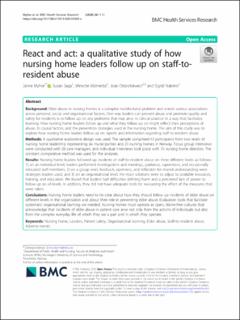| dc.contributor.author | Myhre, Janne | |
| dc.contributor.author | Saga, Susan | |
| dc.contributor.author | Malmedal, Wenche Karin | |
| dc.contributor.author | Ostaszkiewicz, Joan | |
| dc.contributor.author | Nakrem, Sigrid | |
| dc.date.accessioned | 2020-12-04T14:07:57Z | |
| dc.date.available | 2020-12-04T14:07:57Z | |
| dc.date.created | 2020-12-03T09:28:04Z | |
| dc.date.issued | 2020 | |
| dc.identifier.citation | BMC Health Services Research. 2020, 20 (1111), . | en_US |
| dc.identifier.issn | 1472-6963 | |
| dc.identifier.uri | https://hdl.handle.net/11250/2712019 | |
| dc.description.abstract | Background
Elder abuse in nursing homes is a complex multifactorial problem and entails various associations across personal, social, and organisational factors. One way leaders can prevent abuse and promote quality and safety for residents is to follow up on any problems that may arise in clinical practice in a way that facilitates learning. How nursing home leaders follow up and what they follow up on might reflect their perceptions of abuse, its causal factors, and the prevention strategies used in the nursing home. The aim of this study was to explore how nursing home leaders follow up on reports and information regarding staff-to-resident abuse.
Methods
A qualitative explorative design was used. The sample comprised 43 participants from two levels of nursing home leadership representing six municipalities and 21 nursing homes in Norway. Focus group interviews were conducted with 28 care managers, and individual interviews took place with 15 nursing home directors. The constant comparative method was used for the analyses.
Results
Nursing home leaders followed up incidents of staff-to-resident abuse on three different levels as follows: 1) on an individual level, leaders performed investigations and meetings, guidance, supervision, and occasionally relocated staff members; 2) on a group level, feedback, openness, and reflection for shared understanding were strategies leaders used; and 3) on an organisational level, the main solutions were to adjust to available resources, training, and education. We found that leaders had difficulties defining harm and a perceived lack of power to follow up on all levels. In addition, they did not have adequate tools for evaluating the effect of the measures that were taken.
Conclusions
Nursing home leaders need to be clear about how they should follow up incidents of elder abuse on different levels in the organisation and about their role in preventing elder abuse. Evaluation tools that facilitate systematic organisational learning are needed. Nursing homes must operate as open, blame-free cultures that acknowledge that incidents of elder abuse in patient care arise not only from the actions of individuals but also from the complex everyday life of which they are a part and in which they operate. | en_US |
| dc.language.iso | eng | en_US |
| dc.publisher | BioMed Central | en_US |
| dc.rights | Navngivelse 4.0 Internasjonal | * |
| dc.rights.uri | http://creativecommons.org/licenses/by/4.0/deed.no | * |
| dc.title | React and act: a qualitative study of how nursing home leaders follow up on staff-to-resident abuse | en_US |
| dc.type | Peer reviewed | en_US |
| dc.type | Journal article | en_US |
| dc.description.version | publishedVersion | en_US |
| dc.source.volume | 20 | en_US |
| dc.source.journal | BMC Health Services Research | en_US |
| dc.source.issue | 1111 | en_US |
| dc.identifier.doi | 10.1186/s12913-020-05969-x | |
| dc.identifier.cristin | 1855623 | |
| dc.description.localcode | Open Access This article is licensed under a Creative Commons Attribution 4.0 International License, which permits use, sharing, adaptation, distribution and reproduction in any medium or format, as long as you give appropriate credit to the original author(s) and the source, provide a link to the Creative Commons licence, and indicate if changes were made. The images or other third party material in this article are included in the article's Creative Commons licence, unless indicated otherwise in a credit line to the material. If material is not included in the article's Creative Commons licence and your intended use is not permitted by statutory regulation or exceeds the permitted use, you will need to obtain permission directly from the copyright holder. To view a copy of this licence, visit http://creativecommons.org/licenses/by/4.0/. The Creative Commons Public Domain Dedication waiver (http://creativecommons.org/publicdomain/zero/1.0/) applies to the data made available in this article, unless otherwise stated in a credit line to the data. | en_US |
| cristin.ispublished | true | |
| cristin.fulltext | original | |
| cristin.qualitycode | 2 | |

